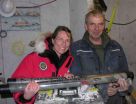(Press-News.org) In a 0-60 mph stand off, most cars would be hard pressed to give a cheetah a run for its money, and at their highest recorded speed of 29m/s (65mph) cheetahs easily outstrip the fastest greyhounds. But, according to Alan Wilson from the Royal Veterinary College, UK, there is no clear reason for the cheetah's exceptional performance. 'Cheetahs and greyhounds are known to use a rotary gallop and physically they are remarkably similar, yet there is this bewitching difference in maximum speed of almost a factor of two', he says. Teaming up with Penny Hudson and Sandra Corr, Wilson decided to compare how cheetahs and greyhounds sprint to see if there were any mechanical differences between the two animals' movements and they publish their findings in The Journal of Experimental Biology at http://jeb.biologists.org.
Knowing that captive big cats are happy to chase a lure, the trio were confident that they could get the cheetahs at ZSL Whipsnade Zoo, UK, and the Ann van Dyk Cheetah Centre, South Africa, to sprint across force plates buried in a track in the animals' enclosure. The problem would be getting the valuable equipment to work in the open. 'Force plates are cosseted, loved pieces of equipment that people don't generally take outside of the lab and bury in the ground in the English summer', Wilson chuckles. However, after successfully installing eight force plates in the cheetahs' enclosure, along with four high speed cameras filming at 1000frames/s, Hudson tempted the cheetahs to gallop along the track with a piece of chicken attached to a truck starter motor while she measured the forces exerted on the animals' limbs, their body motion and footfall patterns. She also repeated the measurements on galloping greyhounds back in the lab, filming the animals at a slower 350frames/s.
But, when Hudson compared the animals' top speeds, she was surprised to see that the trained greyhounds galloped faster than captive cheetahs, clocking up a top speed of 19m/s compared with the cheetahs' 17.8m/s. Nevertheless, Hudson was able to identify clear differences in the animals' stride patterns that could explain how wild cheetahs would outpace the dogs.
When running at the same speed, the big cats' stride was slightly longer than the greyhounds', although the cheetahs compensated for this with a slightly lower stride frequency. Also, the cheetahs increased their stride frequency as they shifted up through the gears – running at 2.4strides/s at a leisurely 9m/s, rising to 3.2strides/s at their top speed of 17m/s – whereas the greyhounds maintained a constant stride rate around 3.5strides/s across their entire speed range. Wilson suspects that wild cats may be able to reach stride frequencies of 4strides/s, which, in combination with longer stride lengths, may allow them to outstrip their captive cousins and hit top speeds of 29m/s.
Also, when Hudson analysed the length of time that each animal's foot remained in contact with the ground – the stance time – she noticed that for some of the cheetah's limbs it was longer, and the team suspects that this may be another factor that contributes to the wild cheetah's record performance. Explaining that increasing the stance time reduces the peak loads on the animal's legs, Wilson says, '[with] a longer stance time the cheetah will get to the limiting load at higher speed than the greyhound'.
Speculating about the relatively poor performance of the captive cheetahs, Wilson suggests that they may lack motivation. 'They have lived in a zoo for several generations and have never had to run to catch food. They have probably never learned to run particularly', he says, adding, 'The next stage is to try to make measurements in wild cheetahs in the hope of seeing higher speeds.'
###
IF REPORTING ON THIS STORY, PLEASE MENTION THE JOURNAL OF EXPERIMENTAL BIOLOGY AS THE SOURCE AND, IF REPORTING ONLINE, PLEASE CARRY A LINK TO: http://jeb.biologists.org/content/215/14/2425.abstract
REFERENCE: Hudson, P. E., Corr, S. A. and Wilson, A. M. (2012). High speed galloping in the cheetah (Acinonyx jubatus) and the racing greyhound (Canis familiaris): spatio-temporal and kinetic characteristics. J. Exp. Biol. 215, 2425-2434.
This article is posted on this site to give advance access to other authorised media who may wish to report on this story. Full attribution is required, and if reporting online a link to jeb.biologists.com is also required. The story posted here is COPYRIGHTED. Therefore advance permission is required before any and every reproduction of each article in full. PLEASE CONTACT permissions@biologists.com
THIS ARTICLE IS EMBARGOED UNTIL THURSDAY, 20 June 2012, 00.15 HRS EDT (04:15 HRS GMT, 05:15BST)
END
A pioneering report of genome-wide gene expression in autism spectrum disorders (ASDs) finds genetic changes that help explain why one person has an ASD and another does not. The study, published by Cell Press on June 21 in The American Journal of Human Genetics, pinpoints ASD risk factors by comparing changes in gene expression with DNA mutation data in the same individuals. This innovative approach is likely to pave the way for future personalized medicine, not just for ASD but also for any disease with a genetic component.
ASDs are a heterogeneous group of developmental ...
The dynamic properties of the skin that take charge when a cut or scrape needs healing are critical for maintaining the skin's integrity, but if they get out of control, they can cause problems in the form of psoriasis and other skin disorders. Researchers reporting on June 21st in the Cell Press journal Immunity have now uncovered key information on how cells are stimulated to multiply during these processes. The information might be used to develop new treatments for psoriasis and hard-to-heal skin wounds.
For their studies, the scientists analyzed skin biopsies from ...
In the aftermath of the Deepwater Horizon oil spill in the Gulf of Mexico two years ago, various strategies were deployed to prevent 4.9 million barrels of light crude oil from fouling the waters and reaching the shores. A team of Lawrence Berkeley National Laboratory (Berkeley Lab) researchers found that nature also played a role in the dispersal process as marine microbial communities responded to the oil plume that made its way from the wellhead at a depth of 5,000 feet to the surface of the water.
"There was oil on the surface and oil below, but no oil in between," ...
This past Father's Day had many children across the country appreciating the support and presence of their fathers. However, for many returning soldiers, this appreciation proved especially difficult as they reintegrate with their families. A recent article from CNN expresses the many concerns that these veterans have as they attempt to reestablish bonds with their children after returning home from a war zone. Dr. Gordon T. Austin, an award-winning Oral and Maxillofacial Surgeon and US Navy Veteran, confirms that this process is especially challenging and encourages children ...
AUDIO:
Cell PaperClip for Cell Volume 149 Issue 7 featuring an interview with author Dr. Dennis Kasper
Click here for more information.
Mice carrying a set of friendly microbes that are usually found in humans fail to develop a proper immune system and are left susceptible to illness as a result. The findings in the June 22nd issue of the journal Cell, a Cell Press publication, show that animals have coevolved with and rely on their own very special array of microbial partners. ...
ARLINGTON, Va. (June 21, 2012) – A team led by researchers at Winrock International, a U.S. environmental nonprofit organization, has developed an estimate of gross carbon emissions from tropical deforestation for the early 2000s that is considerably lower than other recently published estimates.
The Winrock team, which included scientists from Applied GeoSolutions, NASA's Jet Propulsion Laboratory and University of Maryland, combined the best available spatially consistent datasets on gross forest loss and forest carbon stocks to track emissions from deforestation in ...
COLOGNE, Germany; AMHERST, MA, USA; MAGADAN, Russia. -- First analyses of the longest sediment core ever collected on land in the terrestrial Arctic, published this week in Science, provide documentation that intense warm intervals, warmer than scientists thought possible, occurred there over the past 2.8 million years.
Further, these extreme warm periods correspond closely with times when parts of Antarctica were ice-free and also warm, suggesting strong inter-hemispheric climate connectivity. "The polar regions are much more vulnerable to change than we thought before," ...
According to a Wall Street Journal article, Indian government officials have introduced a bill into Parliament that will hand over power to the country's central bank to manage the microfinance sector. This sector is generally charged with lending money to small borrowers. Finance Minister Pranab Mukherjee introduced the Microfinance Institutions (Development and Regulations) Bill to Parliament so the Reserve Bank of India will set a maximum interest rate that can be charged by micro lenders. Abake Assongba, the founder of the nonprofit organization, Abake's Foundation, ...
Three Simon Fraser University scientists are engaging in a verbal battle with the federal government over its budget cuts and legislative changes in departments with environmental responsibilities, on a powerful stage.
Science, a research journal with more than one million readers worldwide, has just published online (appearing in the June 22 hardcopy issue) a letter to the editor written by the SFU trio.
In their letter, Canada's Weakening Aquatic Protection, Brett Favaro, a biology doctoral student, and biology professors John Reynolds and Isabelle Côté criticize ...
A research team led by astronomers at the University of Washington and Harvard University has discovered a bigger version of Earth locked in an orbital tug-of-war with a much larger, Neptune-sized planet as they orbit very close to each other around the same star about 1,200 light years from Earth.
The planets occupy nearly the same orbital plane and on their closest approach come within about 1.2 million miles of each other – just five times the Earth-moon distance and about 20 times closer to one another than any two planets in our solar system.
But the timing ...

